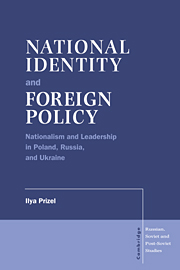Book contents
- Frontmatter
- Contents
- Preface
- Introduction: statement of arguments
- 1 National identity and foreign policy: a dialectical relationship
- 2 Polish identity 1795–1944: from romanticism to positivism to ethnonationalism
- 3 Poland after World War II: native conservatism and the return to Central Europe
- 4 Polish foreign policy in perspective: a new encounter with positivism
- 5 Russia's national identity and the accursed question: a strong state and a weak society
- 6 Russian identity and the Soviet period
- 7 Russia's foreign policy reconsidered
- 8 Ukraine: the ambivalent identity of a submerged nation, 1654–1945
- 9 Ukraine after World War II: birth pangs of a modern identity
- 10 Foreign policy as a means of nation building
- 11 Conclusion: national identity and politics in the age of the “Mass-Man”
- Index
- Cambridge Russian, Soviet and Post-Soviet Studies
3 - Poland after World War II: native conservatism and the return to Central Europe
Published online by Cambridge University Press: 18 December 2009
- Frontmatter
- Contents
- Preface
- Introduction: statement of arguments
- 1 National identity and foreign policy: a dialectical relationship
- 2 Polish identity 1795–1944: from romanticism to positivism to ethnonationalism
- 3 Poland after World War II: native conservatism and the return to Central Europe
- 4 Polish foreign policy in perspective: a new encounter with positivism
- 5 Russia's national identity and the accursed question: a strong state and a weak society
- 6 Russian identity and the Soviet period
- 7 Russia's foreign policy reconsidered
- 8 Ukraine: the ambivalent identity of a submerged nation, 1654–1945
- 9 Ukraine after World War II: birth pangs of a modern identity
- 10 Foreign policy as a means of nation building
- 11 Conclusion: national identity and politics in the age of the “Mass-Man”
- Index
- Cambridge Russian, Soviet and Post-Soviet Studies
Summary
Poland has a thousand year history and no yesterday to which to refer.
Juliusz MieroszewskiThe aftermath of World War II
The suffering, destruction, and humiliation endured by the Polish people during World War II recast Poland. Geographically, it was moved west, and its population changed from one of the most heterogeneous to one of the most homogeneous in Europe. Much of the prewar political and cultural elite of the nation was annihilated by Stalin and Hitler, and its remnants were forced into long, involuntary exile. The Poland that emerged from the war was psychologically, sociologically, and economically different from the Second Republic. In psychological terms, World War II, unlike Pilsudki's struggle for independence, was a truly national war embracing every layer of Polish society and embodying a powerful collective experience on an unprecedented scale. Economically, the harnessing of Poland's economy to the Reich's war machine resulted in significant industrialization of the country (in the area between the Oder and Bug rivers, the number of industrial workers increased threefold during the war) as well as the establishment of economic etatism, which did not exist before the war.
Sociologically, the Polish elite that emerged from the ruins of the war developed a very different sense of Poland's place within the international system, as well as a notion of Polishness that differed markedly from that of the interwar elite. Not only were the old Polish intelligentsia and elite annihilated or driven abroad, but also, as Krystyna Kersten noted: “The middle class ceased to exist as a social stratum, as did the land owners, as a result of the land reform, more than 10,000 landowners were expropriated, 13, 243 estates were either parceled out or placed under state control.”
- Type
- Chapter
- Information
- National Identity and Foreign PolicyNationalism and Leadership in Poland, Russia and Ukraine, pp. 75 - 108Publisher: Cambridge University PressPrint publication year: 1998



